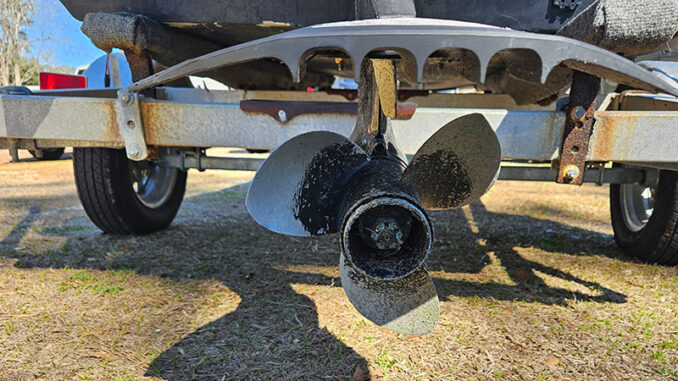
Offshore fishing in the Carolinas might be the most exciting thing you can experience in the outdoor world. Of course, that’s just my opinion, and some trips to the deep are a lot better than others. A lot of days are spent 40 to 60 miles offshore, however, where the weather is marginal, and the bite is slow.
Thinking back over all the days spent on the water, I think the most concentration of fun comes from inshore fishing. If for no other reason, inshore fishing is great because you are generally fishing a lot more than you are running. But you do run some, often in some tight quarters and in shallow water. You have different things to think about when you’re captaining a 19- to 21-foot bay boat with a 115-horsepower outboard, versus a larger center console with multiple engines. Performance often takes on a different look in the sound or the inlet than it does offshore.
It’s pretty much a given that offshore boats will perform better with shiny stainless-steel props. In that game, the only variables are the size and shape characteristics (pitch, cup, and rake) of the props themselves. Marine dealers often try to apply the same logic when it comes to the props on inshore boats as well. The simple and ugly truth of that matter is that stainless steel props cost a lot more than aluminum ones, and a higher priced prop makes them more money when the boat or just the motor is sold. So, most dealers train their sales staff to sell that way.
Choices
Mickey Thompson owns and operates Sportsman’s Choice Marine in Little River, South Carolina. I worked as his sales manager for about two years, immediately after I left charter fishing full time. Mickey taught me more about props in those two years than the sum total of all of my experience on the water. He gained his wealth of knowledge racing boats in his youth, and I can say that he is more knowledgeable about propping a boat correctly than anyone I have ever spoken with. Mickey dials his customers (especially first-time boat owners) in on the right prop for their setup by first asking “What are you mainly going to be doing with the boat.” If inshore fishing is the answer, he’s not hesitant to present an aluminum prop as a viable, and perhaps better option.
Aluminum has some drawbacks as a prop material. It’s nowhere near as strong as stainless. So it will often flex at higher throttle settings, not to mention being thicker and less hydrodynamic. You won’t achieve quite the same fuel efficiency or top speed when running with an aluminum “wheel.” Saltwater is much harsher on aluminum than on stainless. After a season of solid use, even without hitting anything, your aluminum prop is going to be a lot less pretty than its shiny cousin. But what if you do hit something?
Flex isn’t all bad
The reduced strength of aluminum might be one of its best qualities when it comes to inshore fishing boats. Shallow water captains that catch fish often take risks, like trying to get over a sandbar or creeping up over oyster beds to get a bit closer to a known redfish hole. Sometimes it’s just a function of fishing somewhere you are unfamiliar with. Or a full moon plus a little wind from the beach pushing offshore results in a drainer tide. Whatever the factors are, you are probably going to make hard contact with something submerged when you’re chasing trout, drum, or flounder. Then your propeller is going to come to a stop, very quickly.
If you’re running at any speed at all, chances are good that you’re going to damage something that contacted the bottom, or maybe that submerged piling that couldn’t be seen. That same flex that robbed you of a bit of speed might be your best friend when your prop crumples or even loses a blade. When a stainless prop makes hard contact at speed with a solid object, it often doesn’t get damaged much at all. The weakest link in the system is what takes the damage. With stainless props, the weakest link is quite often the gearcase. Even if the boat is still operable after the quicker-than-expected stop, you might find some metal in the lube the next time you service your lower unit. The gears took the brunt of the collision and not the prop. Gear cases are a lot more expensive to repair than props, and you’re usually going to be out of the water for a while. Not to mention, you can usually buy about three aluminum props for the price of a single stainless one.
Whatever prop material you choose to go with, I heartily recommend that you always carry a spare, along with a spare hub kit (unless your hubs are pressed in), a prop wrench, and a block of wood. Even if an aluminum prop saved your lower unit from the “hand grenade” experience, you don’t want to run with a damaged prop for any longer than you absolutely must. The cavitation caused by the disrupted water flow can damage the gearcase as well, especially by bending the shaft or causing water intrusion around the seals. Best to just change out to your spare as soon as you safely can. The damaged prop can be repaired later and potentially then become your spare going forward.
One final thing, aluminum is a paintable metal, whereas stainless isn’t. Every marine store sells inexpensive cans of “prop paint.” You can quickly make your aluminum prop look new again. If you’re the type who’s nice enough to lend your bay boat to a friend for the day, give at least the edges of the prop a quick (but secret) spray the night before and make them promise not to run aground. When they return your boat and tell you they never touched the bottom, but you see bare aluminum on the edges of the blades, just handle as you see fit. At the very least, you now have some ammo for a good joke over an after-fishing drink.
Stainless steel isn’t always better:
Stainless steel props are considerably stronger than aluminum ones, but if your prop hits a solid object, that strength can lead to a problem with other components of your outboard engine.




Be the first to comment